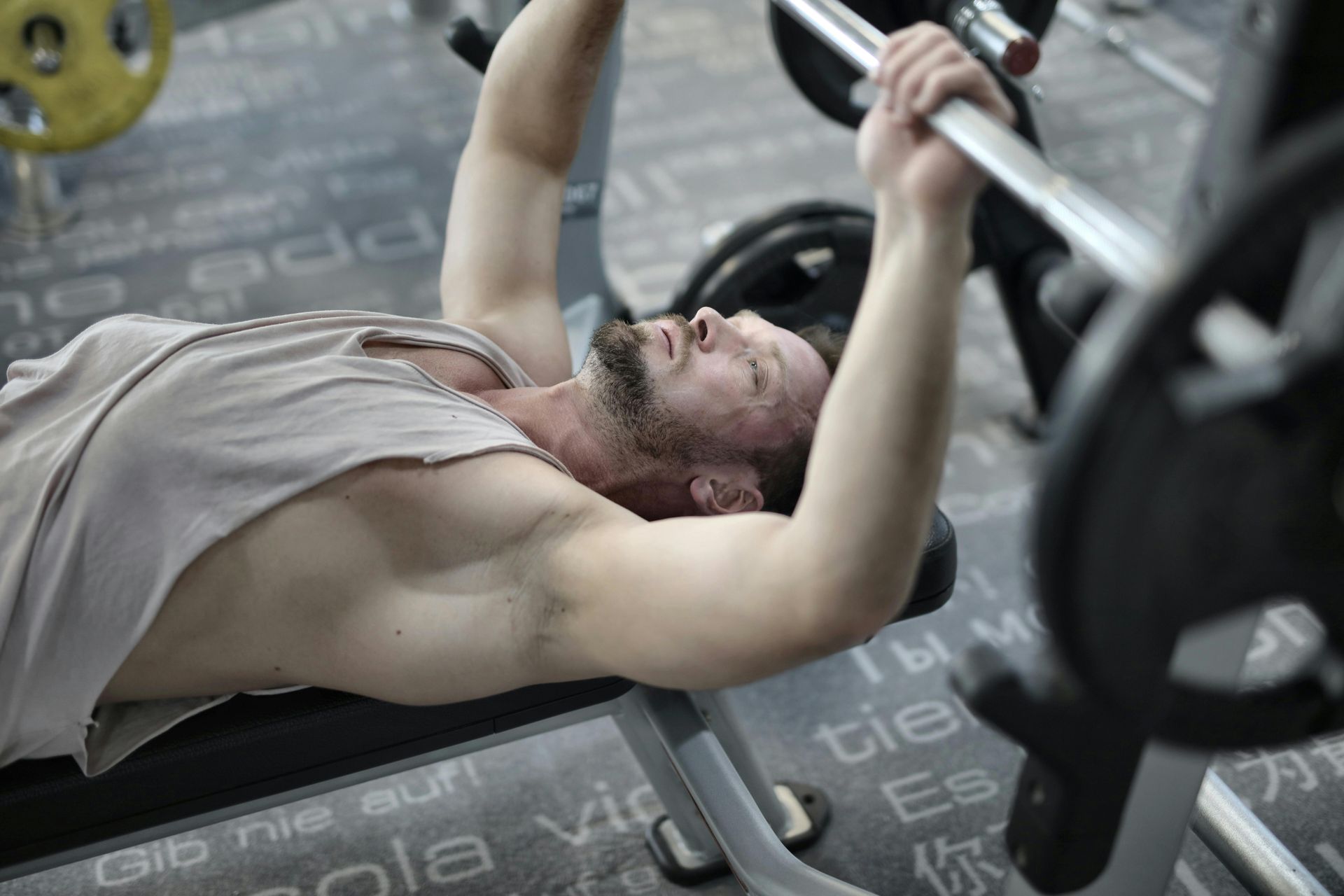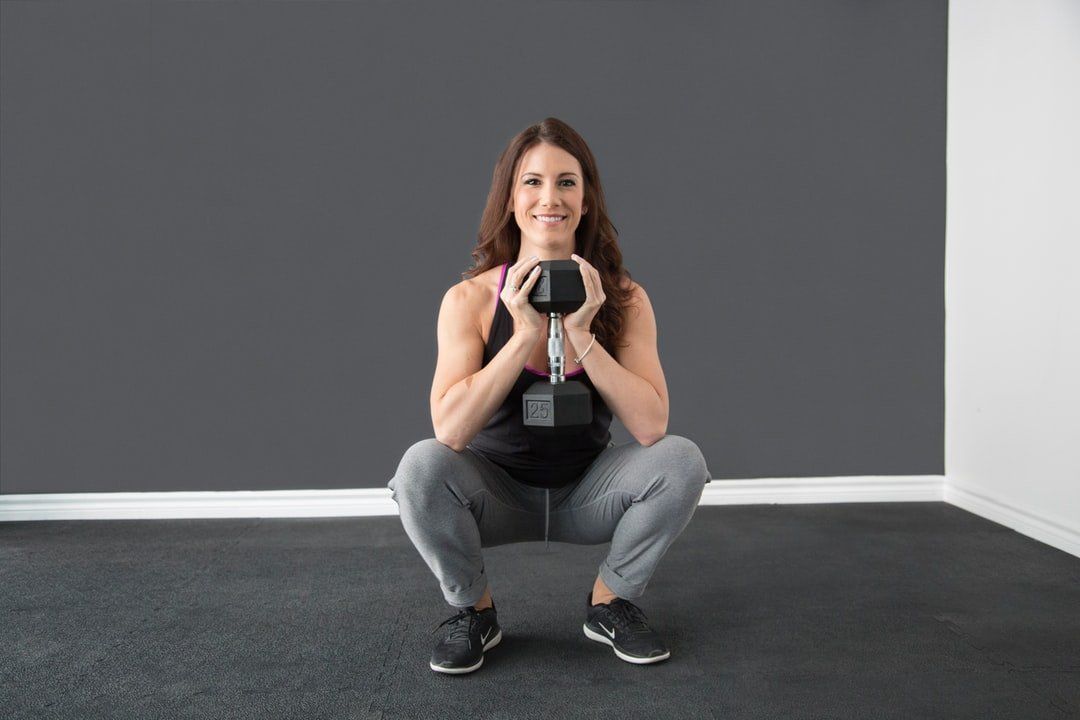How to Build Muscle
A Brief Guide

For those who are curious about building muscle whether you are an athlete, a sedentary person considering the idea of getting more active, or a current lifter interested in getting more jacked, it can sometimes be a little challenging to know what to do. Fortunately, there are a handful of scientific principles that can help us develop practical strategies.
First, let’s begin by talking about muscle growth and who should consider it as a goal. Muscle growth, or muscular hypertrophy as it is known in the scientific literature, is the increase in muscle fiber size and is a complex process involving several processes. The most important is mechanical tension. This is considered a primary driver of hypertrophy. When muscles are subjected to resistance (like lifting weights), it creates tension within the muscle fibers. This mechanical stress triggers signaling pathways that stimulate muscle protein synthesis (MPS).
The second important process is muscle damage. However, the exact nature and extent of its contribution are still subjects of ongoing research. Resistance training, particularly eccentric muscle actions (lengthening of the muscle under load), causes microscopic damage to muscle fibers. This microtrauma initiates an inflammatory response, which is essential for muscle repair and growth. Satellite cells, which are muscle stem cells, are activated to help repair the damaged fibers, contributing to hypertrophy.
The third process is metabolic stress. High-intensity exercise leads to the accumulation of metabolic byproducts, such as lactate and hydrogen ions. This metabolic stress can contribute to hypertrophy via a number of different pathways, one possible pathway may involve influencing anabolic (tissue building) hormone release. It should be emphasized that it takes a secondary, supportive role to mechanical tension.
While there is more to hypertrophy, this should serve as a good baseline of working knowledge that will help those interested in strategies that I will discuss, but first let’s consider who should be concerned with muscle hypertrophy.
Who should care about muscle growth?
In my post titled “Why Women Should Take Creatine”, I discussed a condition called sarcopenia which is defined as the age-related loss of muscle mass and strength. Sarcopenia poses significant risks to both men and women, impacting their overall health, independence, and quality of life. Since we all age, this is something we must all contend with.
Others may consider hypertrophy as a training goal such as physique athletes, powerlifters, and other kinds of athletes such as the more obvious kinds like American football players, and even the less obvious kinds such as swimmers, endurance runners, and triathletes. Muscle growth can also be useful for those seeking to lose weight or develop a more lean appearance.
Whatever the goal, some degree of muscle growth is going to be beneficial and we can all stand to benefit in a variety of ways, so how does one go about achieving this?
Science-based Training Principles for Muscle Growth
When focusing on training principles for muscle hypertrophy, we ought to consider how to manipulate different exercise variables to influence muscle growth. These principles include progressive overload, training volume, training intensity, exercise selection, training frequency, rest intervals, variation, proximity to failure, and emphasizing the stretch. I will consider each individually:
Progressive overload: To continually elicit muscle growth, you must consistently increase the demands placed on your muscles. This can be achieved by increasing the load (e.g., weight lifted), increasing the number of repetitions, increasing the number of sets, decreasing rest periods, increasing the frequency of training, and changing exercise variations to more challenging ones.
Training volume: Training volume refers to the total amount of work performed. It’s typically calculated as sets x reps x load. However, since the number of sets one can do is inversely related to both the number of repetitions per set and the load. In other words, the greater the number of repetitions per set or the greater the load lifted, the fewer sets one can do before becoming too fatigued. Therefore, the most practical way to gauge volume is the number of sets one does per muscle group per week.
But how many sets per muscle group per week is optimal? Scientists currently do not know the maximum number of sets one can do for a given muscle group because the point at which an increase in the number or weekly sets one can do before it begins to hinder muscle growth has yet to be definitively established. The literature has demonstrated that volumes in excess of 30 to 40 sets per week, for example, still yield greater amounts of hypertrophy, though the marginal return on investment is considerably less than it is at 10 to 20 sets per week.
This may be fine and dandy, but the vast majority of people don’t have the time, nor the interest for that matter, to invest in developing maximal muscle growth. After all, most people don’t want to be bodybuilders and spend hours in the gym most days of the week. Full time jobs, family commitments, and social lives also make this kind of investment impractical. So the number of weekly sets one should include in their training is going to depend on all of these constraints. For most, 10 to 20 sets per week works really well. However, some might not have time to do even that much. Fortunately, there has been recent research done on the minimum effective training dose.
The concept of the minimum effective training dose (METD) is about finding the smallest amount of training that yields significant increases in strength and muscle growth. This is particularly relevant for those with more severe time constraints. Research suggests that a minimum of around 4 sets per muscle group per week can elicit detectable increases in muscle growth as long as all sets are taken up to two repetitions in reserve before reaching failure, although going all the way to failure may be more ideal.
Training intensity: Intensity refers to the amount of weight lifted relative to your one-repetition maximum (1RM). For hypertrophy, moderate intensities (typically 65-85% of 1RM) are generally recommended. This generally translates to a repetition range of 6-12 repetitions. Recent research shows that intensities 30% to 85-90% which translates to a range of 5-50 repetitions. However, the 6-12 repetition range is a fairly practical and effective range for most people, though it may still be a good idea to do anywhere from 5 to 15 repetitions during one’s training program depending on one’s goals and constraints.
Training frequency: Training each muscle group 2-3 times per week is generally recommended. However, an individual’s recoverability, overall weekly training volume, and other constraints will determine one’s optimal frequency. Generally speaking, frequency is secondary to volume. There isn’t a lot of evidence supporting the idea of frequency being a significantly impactful variable in itself outside of its contribution to total weekly volume.
Rest intervals: Moderate rest periods of 1 to 2 minutes between sets are generally optimal for hypertrophy. One minute tends to suffice for isolation exercises (e.g., biceps curls) while 2 minutes may be better for compound lifts involving multiple major muscle groups (e.g., barbell back squats).
Variation: Varying your exercises, rep ranges, and training volume can help to prevent plateaus and keep your muscles adapting. However, there is such a thing as too much variation. Typically, you should stick with the same, or similar, exercises for at least a few weeks before switching them up. This will allow to better gauge your progress and systematically apply progressive overload. In the meantime, the primary variables that can be varied are load, repetitions, and volume (incrementally over time).
Proximity to Failure: Proximity to failure is also important. Training to failure refers to pushing yourself until you can no longer perform an exercise with proper form. There are two main types of failure: muscular (true) failure and technical failure. Muscular failure is the point where your muscles can't generate enough force to overcome the resistance for another full repetition (rep). Technical failure occurs when you can no longer maintain proper form during a rep even though you might be able to push out another rep with compromised form. Training to failure is a beneficial technique for lifters aiming to maximize muscle growth.
It should be noted that not all sets necessarily need to be taken to failure. While it is more advisable for low volume programs, it may hinder higher volume programs by intruducing higher levels of fatigue earlier on in a workout, thus making higher volume training less feasible.
To avoid early-onset fatigue, it's advisable to lift until there are up to 3 repetitions in reserve (RIR; the number of reps you can still do before hitting failure) for at least the first couple of sets during an exercise (or perhaps even all sets for exercises such as barbell back squats, especially in the absence of a spotter, due to the associated systemic fatigue and safety-related factors), and progressively getting closer and closer to failure until finally reaching it on the last set. Robinson, Pelland, and Remmert of Data Driven Strength argue that the literature suggests one can still experience substantial hypertrophy up to ">4 RIR".
Emphasizing the Stretch: The relationship between muscle length and hypertrophy is a topic of increasing interest in exercise science. For example, research suggests that emphasizing training in lengthened muscle positions can enhance hypertrophy. This means that the degree to which a muscle is stretched during an exercise can influence its growth. It also appears that placing peak tension on a muscle when it is in a lengthened position is particularly effective.
These findings suggest that incorporating exercises that emphasize lengthened muscle positions into training programs can be beneficial for maximizing muscle growth. Examples include performing deep squats to emphasize the lengthened position of the quadriceps and gluteals, or using exercises that provide resistance in the stretched position of the target muscle such as certain cable exercises.
Nutrition
Optimizing nutrition is absolutely critical for maximizing muscle hypertrophy. Without adequate support in these areas, your training efforts will be significantly hindered. Now let’s talk about protein. Protein is the fundamental building block of muscle tissue. For hypertrophy, you generally want to aim for a daily intake of 0.7-1 gram per pound of body weight (if you are considered “overweight”, then it should be per pound of a reasonable goal weight). However, more recent evidence suggests that optimal protein intake may be higher (about 1-1.3 grams per pound of bodyweight). Generally speaking, and for practical reasons, 1 gram per pound should be fine for the overwhelming majority of people.
While recent evidence suggests protein timing and daily intake distribution isn’t as critical as used to be thought, it is still a good idea to distribute protein intake throughout the day (e.g., 20-40 grams per meal) to maximize muscle protein synthesis (MPS) for practical reasons. For example, my daily protein intake goal is a range from 150-190 grams. I usually get 60 grams at breakfast, 30 grams at lunch, drink a protein shake with 50 grams, and have 30 grams at dinner for a total of 170 grams per day. Since I am a swimmer and not a bodybuilder, this suits my goals just fine. Okay, but what about calories?
To build muscle, it is ideal to be in a slight caloric surplus (consuming more calories than you expend). This provides the energy needed for muscle protein synthesis and growth. It is generally recommended to aim for a small surplus of around 250-500 calories per day. However, an excessive caloric surplus can lead to unwanted fat gain. For those who also wish to lose weight or become leaner, it is possible to promote muscle growth at maintenance calories or even at a small deficit (less than 500 calories), but muscle growth will be less than optimal.
Another thing to consider is hydration. Muscle tissue is largely composed of water and proper hydration is essential for muscle function, nutrient delivery, and recovery. Drink plenty of water throughout the day, especially before, during, and after exercise.
Vitamins and minerals also play crucial roles in various physiological processes, including muscle growth and recovery. A balanced diet rich in fruits, vegetables, and other high fiber sources will provide essential micronutrients. However, some individuals may need to supplement, especially those who are prone to deficiencies.
Before delving into the topic of supplements, it is important to note that they are not always essential for achieving significant gains. However, certain supplements, such as creatine and caffeine, can assist in optimizing results. Most supplements, like branched-chain amino acids (BCAAs), are largely unnecessary and can be considered a waste of resources because BCAAS are already contained in complete protein sources like meat or whey protein. If one meets their daily protein needs, they automatically get enough BCAAs.
Whey protein is a high-quality protein source that can be particularly useful when there are concerns about adequate nutrition. It is worth mentioning that collagen, the protein found in connective tissues like joints and ligaments, is not an ideal supplement for muscle growth. This is because it lacks certain essential amino acids and is low in others, including leucine, an amino acid that plays a crucial role in MPS. Therefore, it is more beneficial to prioritize whey protein or whole food sources of protein.
For individuals following plant-based diets, protein supplements may be more essential in achieving the recommended daily protein intake. Supplements containing pea or fava bean proteins are generally considered good sources. It is advisable to choose supplements that utilize a blend of these proteins. What about soy protein? Soy protein is considered a complete protein, meaning that it contains all essential amino acids like whey protein does (though their amino acid profiles do differ). Like whey, soy is considered a high-quality protein. It should be noted that soy does not significantly affect testosterone levels in men. Thus, the term "soy boy" is purely pejorative and lacks any kind of basis in reality.
Caffeine serves as a decent pre-workout supplement, as it has been demonstrated to enhance muscular endurance and strength. While there are various pre-workout products available, caffeine alone can provide similar benefits without the unnecessary additives found in other products. However, it is crucial to exercise caution, as there are certain medical conditions for which caffeine consumption may not be recommended:
- Severe anxiety
- Cardiovascular disease or symptomatic cardiac arrhythmia
- Peptic ulcer disease or gastroesophageal reflux disease
- Hepatic (liver) impairment
- Renal (kidney) impairment
- Seizures
- Pregnancy
Please be informed that consuming caffeine within 13 hours of bedtime may adversely affect sleep, which is crucial for recovery. Therefore, if you engage in weightlifting during the afternoon or evening, it would be advisable to refrain from caffeine supplementation. However, if you work out in the morning and do not have any of the aforementioned conditions, feel free to consume caffeine.
Then there is creatine which is a naturally occurring substance found in muscles and can also be obtained through certain foods, such as meat and seafood. It plays a vital role in providing energy for muscle contractions, especially during brief periods of high-intensity exercise. Creatine supplementation has the potential to enhance muscle growth. Additionally, it is associated with improved performance in activities that require short bursts of strength and power, including weightlifting, sprinting, and interval training.
Daily creatine supplementation should be maintained between 3-5g. The “loading phase” can be omitted, particularly since it has been associated with certain gastrointestinal issues. It is crucial to acknowledge that while creatine is generally safe for healthy adults, consulting a healthcare professional before initiating any supplements is advisable. They can provide guidance on potential interactions with medications or underlying health conditions.
Can you take both creatine and caffeine together? Yes, but with a significant caveat–if you choose to supplement with creatine and caffeine, ensure that you ingest them at separate times of the day.
Recovery
Sleep is when the body repairs and builds muscle tissue. Aim for 7-9 hours of quality sleep per night. You can optimize sleep hygiene by creating a consistent sleep schedule, creating a dark and quiet sleep environment, avoiding caffeine up to 13 hours before bed, and avoiding alcohol in general.
Allow adequate rest between training sessions (usually around 48 hours) to allow for muscle recovery adaptation. For example, if you train legs on Monday, you can either not workout at all or train upper body on Tuesday, and then train legs again on Wednesday. Avoid overtraining, which can lead to fatigue, injury, and decreased muscle growth. Appropriate rest between sets, and between training days, is very important.
Chronic stress can elevate cortisol (a stress hormone) levels, which can hinder muscle growth and promote muscle breakdown. Practice stress-reducing activities such as meditation, yoga, or spending time in nature.
Active recovery, or light activities such as walking, stretching, or low-intensity swimming, can help improve blood flow and reduce muscle soreness. Foam rolling may also reduce muscle soreness, though these benefits are generally very marginal at best. For instance, I do not foam roll because the benefits do not outweigh the cost of the time it would take to do it as a more advanced trainee. Less advanced trainees may find it more worth the time investment.
Key Takeaways
While there is plenty more that can be said about muscle hypertrophy, this should serve as a useful guide for most. Here are the key takeaways:
Muscle Growth Fundamentals:
- Key Drivers: Mechanical tension is the primary driver of muscle growth. Muscle damage and metabolic stress play supporting roles.
- Who Should Care: Everyone, to combat age-related muscle loss (sarcopenia). Athletes (physique, powerlifting, endurance). Individuals seeking weight loss or a lean physique.
Science-Based Training Principles:
- Progressive Overload: Continuously increase demands on muscles (weight, reps, sets, frequency).
- Training Volume: Sets per muscle group per week are the most practical measure. 10-20 sets are generally effective; 4 sets can yield minimum results. High volume programs are not always practical for most people.
- Training Intensity: 6-12 reps (65-85% 1RM) is a good general range, but a wider range can work.
- Training Frequency: 2-3 times per week per muscle group is recommended, but volume is more important.
- Rest Intervals: 1-2 minutes between sets.
- Variation: Vary exercises, rep ranges, and volume, but avoid excessive variation.
- Proximity to Failure: Training to failure can maximize growth, but not all sets need to be taken to failure. 3 reps in reserve is a good general guideline.
- Emphasizing the Stretch: Training muscles in a lengthened position can enhance hypertrophy.
Nutrition for Muscle Growth:
- Protein: Aim for 0.7-1 gram (or 1-1.3 grams) per pound of body weight. Distribute protein intake throughout the day. Whey protein is a good source, and plant based proteins are good for those following a plant based diet.
- Calories: A slight caloric surplus (250-500 calories) is ideal. Muscle growth is possible at maintenance or a slight deficit, but less optimal.
- Hydration: Essential for muscle function and recovery.
- Vitamins and Minerals: A balanced diet is crucial.
Supplementation:
- Creatine: Enhances muscle growth and performance (3-5g daily).
- Caffeine: Enhances endurance and strength (use with caution).
- Whey Protein: A good supplement for those who have trouble getting enough protein from whole food sources.
- BCAAs: Generally unnecessary if protein intake is adequate.
- Soy Protein: A high quality complete protein source.
- Collagen: Not ideal for muscle growth.
Recovery:
- Sleep: 7-9 hours of quality sleep per night.
- Rest Between Sessions: 48 hours between training the same muscle group.
- Stress Management: Reduce stress to lower cortisol levels (meditation, yoga, nature).
- Active Recovery: Light activity improves blood flow and reduces soreness.
- Foam Rolling: May provide temporary relief, but benefits are marginal, especially for advanced trainees.











